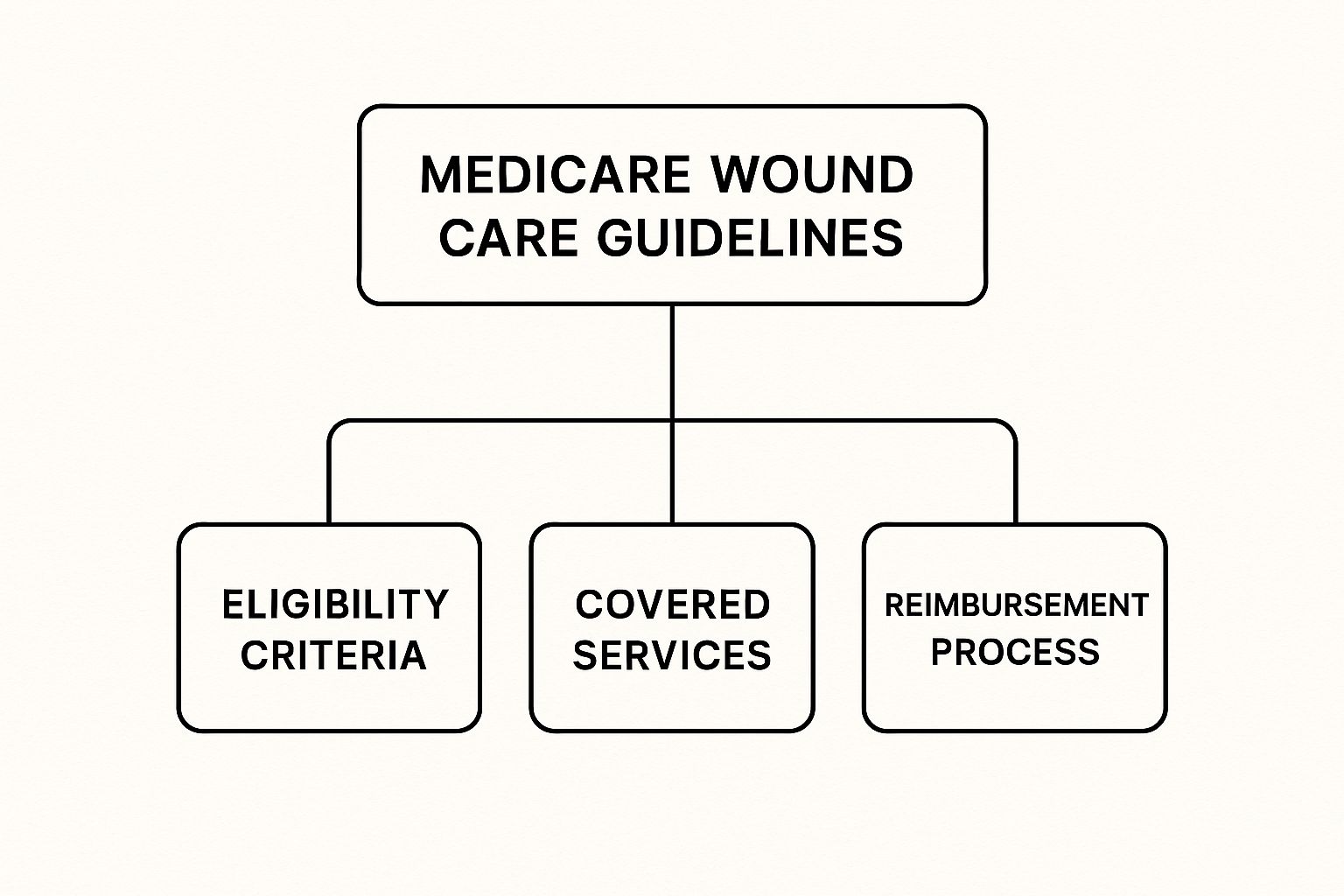Decoding Medicare's Complex Wound Care Framework
Understanding Medicare's wound care system can feel like learning a new language, one where national rules and local dialects must be understood to provide effective, covered care.## Decoding Medicare's Complex Wound Care Framework
Understanding Medicare's wound care system can feel like learning a new language, one where national rules and local dialects must be understood to provide effective, covered care. This system isn't just one set of rules; it’s a framework built on broad federal standards and essential regional guidelines.
Think of it like the national highway system. National Coverage Determinations (NCDs) are the major interstates—the policies set by the federal government that apply to every provider across the country. But much of the real travel happens on the state and county roads, which are the Local Coverage Determinations (LCDs). These are specific rules developed by Medicare Administrative Contractors (MACs), the organizations that manage Medicare claims in different regions. This means the exact requirements for treating a diabetic foot ulcer in Texas might be different from the rules in Oregon. You can find your region's specific policies by searching the CMS Medicare Coverage Database.

This database is the official source for providers to locate the LCDs governing their practice, helping ensure their treatment plans meet all local requirements.
The Interplay of Rules and Regions
Experienced wound care specialists know that mastering their local LCDs is the key to success. Medicare has always insisted on strict adherence to these guidelines to confirm that treatments are both medically necessary and cost-effective. For instance, if a wound is not healing as anticipated, the existing treatment plan must be changed to keep coverage. This requirement highlights a core principle of Medicare: care must be responsive to the patient's actual progress, not just a matter of routine.
This infographic illustrates the fundamental pillars of Medicare's wound care guidelines.

The image shows how eligibility, covered services, and reimbursement are separate but connected parts of the whole system. A mistake in one area can put the entire claim at risk. Whether you are treating a venous stasis ulcer or a post-surgical wound, the type of wound determines the specific services and documentation needed. You may find our guide on the different types of wounds and their treatment considerations helpful. By grasping the logic behind this structure, you can make informed decisions that serve both your patients and your practice.
Navigating Recent Payment And Coverage Changes
The financial side of wound care is always on the move, meaning providers must be as sharp with their finances as they are with their clinical skills. Recent shifts in payment structures mean that a profitable service yesterday might not be today. Staying ahead of these changes is key to running a successful practice while delivering excellent care to your patients.
Understanding the New Reimbursement Landscape
It's a common mistake to view reimbursement as a single, unchanging number. A better way to think of it is a dynamic formula, heavily influenced by national policy decisions. For instance, the Medicare Physician Fee Schedule (PFS) is the rulebook that determines how much providers get paid for their services. Even minor tweaks to this schedule can create major ripples across your practice's finances.
Here’s a glimpse of the Physician Fee Schedule page on the CMS website, which serves as the central hub for these important updates.

This page is your primary source for all files and announcements related to physician payments, making it essential reading for any practice administrator.
The Impact of Fee Schedule Adjustments
The latest updates present a clear financial hurdle. Many Medicare reimbursement rates have been adjusted with the 2025 Medicare Physician Fee Schedule (PFS). The proposed rule reveals that overall average payment rates under the PFS will decrease by 2.93% in 2025 compared to 2024. The conversion factor is also set to drop from $33.29 to $32.35. You can dive into the details in the official fact sheet about the 2025 Medicare Physician Fee Schedule.
This reduction means that for the very same services, providers will receive less money. For a busy clinic, this small percentage can quickly add up to thousands of dollars in lost revenue over the course of a year. The key is to analyze how this change affects your most frequently billed services. If debridement codes are a cornerstone of your practice, for example, a nearly 3% dip demands a strategic response.
This financial pressure makes it even more important to manage complex cases efficiently, like diabetic ulcers, where consistent and effective care can prevent far more expensive complications. For more strategies on this particular challenge, check out our guide on treating diabetic foot ulcers. Thriving practices are now re-evaluating their service mix, focusing on treatments that deliver both high clinical value and sustainable reimbursement. They are also fine-tuning their workflows to lower overhead and communicating these realities transparently to patients and referring physicians—a vital step for maintaining trust and a steady stream of referrals.
Creating Bulletproof Documentation That Protects Your Practice
Solid documentation is your best defense against claim denials and audit headaches. In the world of Medicare, it's not enough to just list the services you provided. Your notes need to tell a clear medical story that justifies why each treatment was necessary, creating a logical narrative of the patient’s journey toward healing. This shift from documenting what you did to why you did it is the key to successful reimbursement under Medicare guidelines for wound care.
From Task Lists to Medical Narratives
Think of your documentation as evidence you're presenting to a reviewer. A simple list of actions, like “debridement performed,” is vague and leaves too much open to interpretation. Instead, your notes should paint a clear picture for anyone reading the file.
- Initial Assessment: Go beyond the basics. Detail the wound's characteristics—its size, depth, tissue type, amount of drainage, and any signs of infection. This sets the baseline.
- Ongoing Progress: At every visit, document the changes. Is the wound getting smaller? Is there less dead tissue? This proves your treatment plan is effective and medically necessary.
- Justification for Therapies: Clearly explain why you chose a specific dressing or type of debridement. Connect your decision directly to the wound's current state and the patient’s overall condition. Was it chosen to manage heavy exudate or to remove stubborn necrotic tissue? Be specific.
This level of detail is more than just good practice. For example, medical centers that carefully log patient outcomes in real-time have been shown to reduce their liability claims by as much as 18%.
To help organize this crucial information, a structured approach to documentation for different treatments is essential. The table below outlines the key components you should include for common wound care procedures.
| Treatment Type | Required Documentation | Frequency | Critical Details |
|---|---|---|---|
| Surgical Debridement | Pre- and post-debridement photos, detailed description of tissue removed (e.g., amount, type), anesthesia used, instruments used. | Per procedure | Justify the medical necessity for sharp debridement over other methods. Note the percentage of wound surface debrided. |
| Negative Pressure Wound Therapy (NPWT) | Wound dimensions, tissue type, drainage amount/color, patient tolerance, dressing change frequency. | At initiation and each follow-up visit (at least weekly) | Document clear evidence of wound improvement or specific goals being met. Justify continued use based on progress. |
| Cellular/Tissue-Based Products (CTPs) | Wound measurements, reason for CTP selection, evidence of failure of standard care (for at least 30 days), specific product name and size. | At application and each follow-up visit | Clearly document why a CTP is needed over standard dressings. Meticulously track wound closure progress after application. |
| Hyperbaric Oxygen Therapy (HBOT) | Documentation of a qualifying chronic condition (e.g., diabetic foot ulcer Wagner Grade III), failed standard wound care, transcutaneous oxygen measurement (TCOM) results. | At initiation and regular intervals (e.g., after 30 sessions) | The initial qualifying documentation is critical. Progress notes must show the wound is responding to HBOT to justify continued sessions. |
In short, the more detailed your notes, the stronger your claim. This table serves as a guide to ensure you're capturing the "why" behind your "what" for every treatment.
Staying Current with CMS Resources
To keep your documentation compliant, it’s important to stay informed about Medicare’s official resources. The Medicare Learning Network (MLN) is a primary source for guidance directly from the Centers for Medicare & Medicaid Services (CMS).

This portal offers publications, web-based training, and official updates that help providers understand and apply complex regulations. By building a documentation system that aligns with these official resources, you create a "bulletproof" record that not only supports better patient care but also protects your practice’s revenue from the risk of audits and denials.
Mastering Advanced Therapies and Skin Substitute Success
Advanced wound treatments, such as skin substitutes and allografts, can be game-changers for patient healing. However, getting Medicare to cover them requires a careful and strategic approach. Think of the approval process less like a single checkbox and more like a detailed journey where every step must be perfectly documented. The entire process rests on one foundational rule: you must first prove that standard wound care has failed, a key requirement under the Medicare guidelines for wound care.
The Critical Four-Week Trial Period
Before Medicare will even consider covering an advanced therapy, a provider has to show that a complete, standard wound care plan was tried and didn't work. This isn't just a suggestion; it's a non-negotiable checkpoint. For a minimum of four consecutive weeks, your documentation needs to paint a clear picture of consistent, conventional care. This includes:
- Regular wound check-ups with precise measurements.
- Consistent use of appropriate wound dressings.
- Necessary debridement to remove non-viable tissue.
- Management of any underlying health issues that affect the wound.
This rule is about to become even more defined. Starting February 12, 2025, the Centers for Medicare & Medicaid Services (CMS) is rolling out new guidelines that will change how these products are reimbursed. A major update is the formal requirement that physicians must document a four-week trial of standard wound care before applying any allograft. You can get more information on these important U.S. government changes to physician reimbursements on parentsguidecordblood.org.
Building a Case for Medical Necessity
To successfully get approval, your documentation has to be airtight. Each note should build on the last, telling the story of a wound that is either stuck or getting worse despite your best efforts. Only after this story is clearly told have you established the medical necessity for a more advanced treatment. You can find the specific rules for your area by searching for the Local Coverage Determination (LCD) on the CMS database.
Here is a look at the LCD search page, which is the official portal for these guidelines.

This database is the final word on the exact documentation and clinical proof your Medicare Administrative Contractor needs for approval.
It’s essential to document every small detail, from how you calculate the size of the substitute to how often it's applied. These are the details that separate an approved claim from a denial. For deeper wounds, the documentation must also show the extra complexity of the care involved. For more on this, you might find our article on how to heal deep wounds faster helpful for clinical tips that go hand-in-hand with these documentation needs. By understanding this timeline and its documentation demands, you can protect your practice’s revenue and ensure patients receive the advanced care they need without unnecessary delays.
Cracking The Code On Billing And Reimbursement Optimization
Smart billing isn't just about picking the right codes. It's about building a claim that tells a clear, accurate story of the care you provided, all while following Medicare guidelines for wound care. The most successful practices understand how individual codes work together, especially in complex situations with multiple procedures or different wound types. This approach ensures you get paid fairly without raising red flags.
Think of billing codes as a language. A single word has its own meaning, but a well-constructed sentence tells the complete story. In the same way, combining the right CPT and HCPCS codes creates a claim that is both clear and easy to justify.
Mastering Essential Billing Codes
The two main code sets you'll be working with are CPT (Current Procedural Terminology) codes and HCPCS (Healthcare Common Procedure Coding System) codes. CPT codes describe the actual procedures you perform, while HCPCS codes are typically used for supplies like dressings and skin substitutes. A common example is pairing a CPT code for debridement with a HCPCS code for a specific wound dressing used.
The Centers for Medicare & Medicaid Services (CMS) offers detailed guidance on these codes. For a deep dive, you can explore the official HCPCS General Information page.
This resource is your official guide to the codes for supplies, drugs, and services, making it an essential tool for compliant billing. Getting this right is critical, as the average ambulatory surgical center sees a 12% claim denial rate. Much of this can be avoided with greater coding precision.
Strategic Modifiers And Appeal Tactics
Modifiers are like the punctuation in your billing language—they add crucial context that can change the entire meaning of your claim. A modifier can specify which side of the body a procedure was performed on or show that multiple distinct procedures happened during one visit. Using them correctly can make a huge difference in your reimbursement.
If a claim gets denied, don't consider it a dead end. A solid appeal strategy is your next step. Winning an appeal often comes down to providing extra documentation that proves the medical necessity you described in the original claim.
Here are a few key strategies:
- Write a Detailed Narrative: Create a clear, brief summary explaining why the service was vital, pointing to specific notes in the patient's chart.
- Cite Peer-Reviewed Literature: Back up your treatment choice by including relevant clinical studies.
- Submit Corrected Coding: If a simple coding error caused the denial, resubmit the claim with the right codes and a clear explanation of the correction.
By getting comfortable with these billing details, your practice can secure proper reimbursement while staying confidently within Medicare's rules.
Building a Sustainable, Compliant Wound Care Program
Creating a wound care program that thrives under Medicare scrutiny is like building a sturdy house. It requires a solid foundation of clinical excellence, a strong framework of operational efficiency, and a protective roof of regulatory compliance. A lasting program isn't just about healing patients; it’s about creating a system that supports those great outcomes while sticking to the strict Medicare guidelines for wound care. This means putting systems in place that ensure consistency, from staff training all the way to patient management.
Establishing Compliant Clinical Protocols
The foundation of any sustainable program is a set of treatment protocols that line up with evidence-based medicine and Medicare’s specific requirements. This isn't about taking away a clinician's judgment, but rather guiding it within a compliant structure. The most successful centers develop internal playbooks that show clinicians the best practices for documentation, how to progress treatments, and when it’s time to move to advanced therapies. This ensures every person on your team knows their role in keeping the program on the right track.
A crucial part of this is continuous staff education. You can find excellent, official resources through the Medicare Learning Network.
This portal offers guidance and training materials straight from the Centers for Medicare & Medicaid Services (CMS), helping you keep your team's knowledge up-to-date. Regularly reviewing these materials can help you spot potential compliance gaps before they turn into expensive problems.
Systems for Quality Assurance and Growth
Beyond the clinical rules, a thriving program needs solid systems for ensuring quality and promoting growth. This includes:
- Outcome Tracking: Put a system in place to monitor how your patients are progressing. This data is priceless for showing your program's value to referring doctors and to Medicare. For instance, centers that carefully track their patient outcomes have been shown to lower their liability claims by as much as 18%.
- Referral Relationship Management: Cultivate strong relationships with the physicians who send you patients by communicating clearly and delivering consistently good results. A steady flow of appropriate referrals is the lifeblood of any specialty service.
- Patient Expectation Management: Educate patients about their treatment plan, what to expect, and what their role is in the healing process. This is particularly important for complex conditions like pressure ulcers, which often demand long-term management at home. For more on this, check out our guide on pressure ulcer treatment home care.
By weaving these elements together, you create a self-improving cycle of excellence. Great clinical outcomes, backed by compliant documentation and efficient operations, build a powerful reputation. This, in turn, draws in more referrals and allows your program to grow in a stable way, benefiting your patients, your partners, and your practice. A well-designed quality assurance protocol acts as your program's internal audit system, making sure you stay on course and are ready for any external review.
Key Takeaways For Medicare Wound Care Success
Succeeding with Medicare’s wound care rules is a mix of clinical expertise, meticulous documentation, and smart planning. To build a program that is both compliant and financially sound, you need to focus on sustainable practices that protect your revenue and ensure patients get the right care at the right time. The following tips are based on the real-world experience of wound care professionals who have figured out the system.
Documentation and Billing Excellence
Think of your patient’s chart as the definitive proof that your services were medically necessary. Every note, measurement, and decision should tell a clear story, explaining why the treatment wasn't just helpful, but absolutely essential. This is a foundational element of the Medicare guidelines for wound care.
- Document the "Why": Don’t just list what you did; explain why you did it. Connect every dressing choice, debridement procedure, and therapy directly to the wound's current condition and the patient's healing progress (or lack thereof).
- Master Modifiers: Use billing modifiers correctly to provide vital context for your claims. Modifiers can prevent denials by explaining situations like performing multiple procedures in one visit or treating wounds on different parts of the body.
- Track Your Metrics: Keep a close eye on your claim denial rates and the average number of days your invoices are in accounts receivable. Practices that achieve accreditation and stick to strict internal documentation protocols often report 15% fewer audit issues. Monitoring these numbers helps you spot and fix problems before they get out of hand.
Patient Management and Compliance
Managing patients effectively goes beyond clinical treatment. It’s about setting clear expectations and maintaining a seamless continuum of care, which is crucial for both positive long-term outcomes and compliance.
- Educate Patients on Their Role: When a patient understands their treatment plan, they are far more likely to stick to it. This is especially true when transitioning care to their home. For great tips, you can find more information on effective post-discharge wound care at home.
- Know Your Audit Triggers: Be aware of common red flags that can prompt a Medicare audit. These often include billing a high volume of advanced therapies without enough justification, inconsistent documentation, or a sudden spike in the use of certain billing codes.
- Stay Current with Regulations: Medicare rules change. Assign a team member to regularly check for updates from your regional Medicare Administrative Contractor (MAC) and the national CMS website. Conducting your own internal audits quarterly can help your center lower potential penalty costs by up to 35%.
By weaving these strategies into your daily workflow, you can build a strong foundation that supports excellent patient outcomes and a healthy, thriving practice.
At Rapid Wound Care, we focus on delivering compliant, expert care directly to patients, acting as a bridge between providers and specialized wound care. If you're looking for a dependable partner for at-home wound management, contact Rapid Wound Care today and discover how our fast-response team can support your patients on their path to healing.

